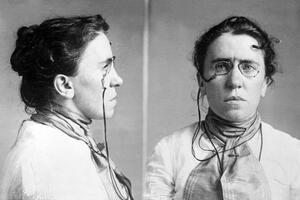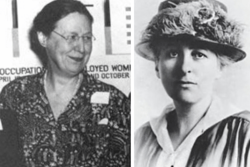Every Emma Needs Her Sidekick
This Women’s History Month, the Jewish Women’s Archive is celebrating the thousands of Jewish women who have participated in activism and resistance in the United States. We all know the names of the most famous women who shaped these movements, from Gloria Steinem to Emma Goldman: the women with the megaphones, with the loud voices and stirring speeches, the women whose names made it into the history books. But one person alone can never make a movement. This month, we’re celebrating the women behind the scenes: the academics, the researchers, the women who posted bail and drove getaway cars for their more famous friends. These behind-the-scenes resistors are not as well-known, but their stories and legacies are no less important than those of the frontline women we all love. Find out more about the project. We hope that by sharing these resistors’ stories and contributions, we will demonstrate that you don’t need the loudest voice or the most extroverted personality to effect change. And we hope to inspire you to bring your own skills to the causes most important to you in 2017.
Chances are, if you follow the Jewish Women's Archive or know anything about the history of early twentieth century progressive and radical movements in the United States, you've heard of Emma Goldman. She's not the kind of historical figure you forget easily: a radical anarchist with an iconic monocle, who espoused free love, who sometimes condoned violence and believed most passionately in the power of education, who met with Vladimir Lenin and found him lacking.
Yes, Goldman was a force to be reckoned with. She had the kind of personality that reverberates through the decades, the kind of face that begs to be emblazoned on a T-shirt. Despite how it may seem, activists like Emma Goldman do not manifest from thin air in times of turmoil to fight the good fight. Their activities and missions take coordination, planning, behind-the-scenes work, the kind of thankless logistical tasks that don't make for good stories.
They take women like Lucy Fox Robins Lang, Emma Goldman's friend.
Lucy Lang was a committed lifelong activist and an anarchist for the first part of her life, but almost all of her invaluable work in service of various causes was behind-the-scenes. She was born in the Ukraine and, at age nine, immigrated first to New York and then to Chicago with her family. As a teenager, while working in a cigar factory, she discovered anarchism. Soon after, she met her first husband, fellow anarchist Bob Robins; true to unconventional anarchist form, they signed a legal contract stating that their marriage would last only five years. Lang and Robins then moved to New York, where they met and befriended Goldman.
Here's the thing about Emma Goldman: she was always getting into trouble. That's kind of the name of the game when it comes to anarchism. And when Goldman got into trouble, Lang got her back out of it. Lang raised bail money for Goldman to spring her from jail after her many arrests. Lang was also heavily involved in planning: she organized speaking engagements for Goldman and other prominent activists, rented halls for their events, and helped bring their ideas and personalities to the attention of the media and America as a whole.
Lang went on to have a long career as an activist after her days at Goldman's side. She traveled around the United States in a mobile home that she designed and drove herself (which she called ‘the Adventurer’). Later in her life, she dedicated herself to the mainstream labor movement as an advisor to the president of the American Federation of Labor. Lang’s story is especially notable this month because of all her behind-the-scenes work for Goldman and, later, for other famous activists. It's not the kind of story that makes it onto a poster or a T-shirt, but it's a reminder to all of us that logistics, details, and the nitty-gritty can be just as important as the grand oration or big personality that makes it into the history books.
Lang wasn't the only contemporary of Emma Goldman who brought practicality to activism. Another anarchist-activist who dealt with logistics to support her more idealistic counterparts was Charlotte Lipsky, activist—and interior decorator.
Lipsky, like Lang, was a Jewish immigrant who came to America as a child and quickly fell in love with Goldman's radical politics. She continued her activist zeal by marrying the “dean of American Zionists,” Louis Lipsky. Louis had a habit of inviting New Yorkers interested in Zionism to take tea at a local inn and listen to him talk about his ideas—then he would pick up the tab for everyone. He was also in the habit of donating most of his paycheck to the Zionist movement.
An ardent supporter of her husband's work, Charlotte Lipsky knew that for her family to continue with their activism, they would need a practical source of income to support those expensive teas and checks. Lipsky, who came from an artistic background, decided to become an interior designer. She didn't have an office, but she used her home as her showroom, and accompanied her clients to shops on the Lower East Side to pick out furniture, fabrics and other decorations. Thanks to Lipsky, the family could continue their political efforts without suffering financially. Although it's tempting to imagine the activist life as one divorced from temporal needs, one where you can live on the zeal of your convictions, this is simply not realistic. Every Louis Lipsky-esque idealist needs a Charlotte Lipsky to ensure that activists can continue to enjoy basic comforts and necessities.
Historians and activists will never forget the names of women like Emma Goldman, whose personality seems designed to live on forever. But it's essential to also remember the Lucy Langs and Charlotte Lipskys. Women like these present us with a more realistic view of activist movements as communal efforts that rely on the nitty-gritty logistics of daily life just as much as they rely on lofty ideals. They are a stark reminder that you can make phone calls, book event spaces, or raise money and still contribute just as much to today's activist movements as the person on the front lines with the bullhorn.







